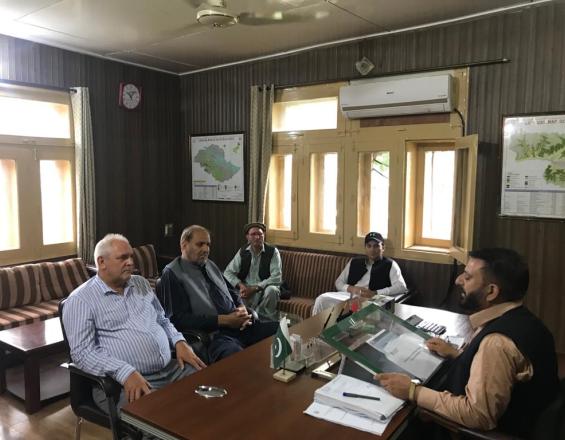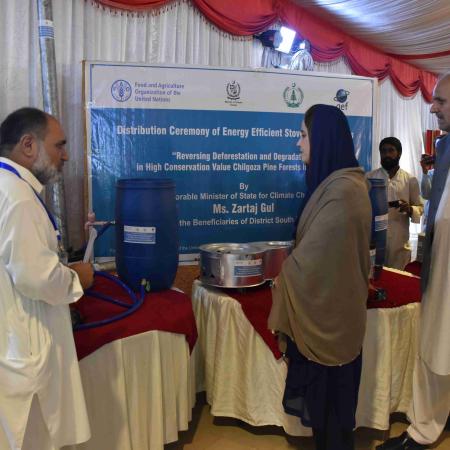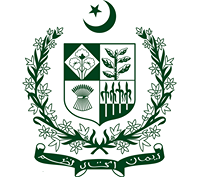
Fortalecimiento e implementación de políticas y marcos jurídicos nacionales y provinciales de FLR para maximizar la gestión sostenible de la tierra en el ecosistema forestal de Chilgoza

La Iniciativa de Restauración (TRI) en Pakistán ha trabajado para reforzar y aplicar políticas y marcos jurídicos de restauración forestal y paisajística (FLR) con el objetivo de maximizar la gestión sostenible de los ecosistemas forestales de Chilgoza. Para ello, TRI Pakistán facilitó el desarrollo de marcos de gestión forestal sostenible y restauración del paisaje en los cuatro distritos de Sherani, Chitral, Suroeste y Gilgit Baltisan (Diamer), cuyo objetivo es abordar las cuestiones económicas forestales, la conservación de la biodiversidad y las preocupaciones sobre los principales factores actuales de degradación forestal. También se basan en los resultados de las evaluaciones participativas de ROAM que identificaron oportunidades de restauración e intervenciones potenciales. Además, TRI Pakistán revisó las políticas existentes y ayudó a promover una transición hacia una aplicación basada en la comunidad y el uso de mecanismos de financiación innovadores y sostenibles, como el pago por ecosistemas y el uso de estufas de bajo consumo de combustible.
TRI es un proyecto financiado por el FMAM.
Contexto
Défis à relever
Uno de los mayores retos a los que se enfrenta TRI Pakistán para alcanzar los objetivos de sus políticas y proyectos es la disponibilidad de recursos. La elaboración de políticas y, sobre todo, su aplicación, requieren muchos recursos para garantizar que se promulgan y aplican todos sus aspectos. Por eso, en parte, la inclusión de las comunidades locales es tan crítica. Los agentes del sector privado son una de las principales fuentes de financiación y, con su participación, las diversas políticas que ha emprendido Pakistán pueden aprobarse y aplicarse adecuadamente. Del mismo modo, la voluntad política del gobierno es fundamental para los cambios políticos, ya que sin su voluntad de consultar a las partes interesadas, el proceso político de FLR habría permanecido aislado en los organismos gubernamentales.
Ubicación
Procesar
Resumen del proceso
El trabajo de TRI Pakistán para revisar los marcos políticos y normativos que promueven el uso de mecanismos financieros sostenibles y para ayudar a desarrollar marcos de gestión forestal sostenible y restauración del paisaje en cuatro distritos de la Selva Chilgoza se une para ayudar a TRI a realizar aportaciones técnicas para las políticas nacionales y ayudar al gobierno de Pakistán a aplicar políticas forestales más centradas en las comunidades locales. Mediante el estudio de mecanismos financieros como los pagos por servicios ecosistémicos y la creación de un estudio de valoración económica que muestra el valor económico de la restauración en los ecosistemas de la Selva de Chilgoza, TRI Pakistán estuvo en mejores condiciones de presentar recomendaciones sobre posibles intervenciones y destacar el valor económico que podría aportar la restauración. Con estas recomendaciones incorporadas a las políticas nacionales y a las medidas de aplicación, los marcos de Pakistán pueden ser más favorables a la FLR. Del mismo modo, con el desarrollo de marcos de gestión y restauración en los cuatro distritos, TRI Pakistán está contribuyendo a la incorporación de la RPF a nivel subnacional y ayudando a fortalecer los marcos legales al garantizar que la implementación de la restauración se está produciendo a nivel local con un enfoque en las prioridades y necesidades de las comunidades locales.
Bloques de construcción
Desarrollo de marcos de gestión forestal y restauración del paisaje para los ecosistemas forestales de Chilgoza
Para reforzar las políticas y los marcos jurídicos de Pakistán en apoyo de la FLR y la gestión sostenible de la tierra, TRI Pakistán ha facilitado el desarrollo de marcos de gestión forestal y restauración del paisaje para los ecosistemas forestales de Chilgoza en los cuatro distritos de Sherani, Chitral, Suroeste y Gilgit Baltisan con aportaciones técnicas y acogiendo y participando en la consulta de las partes interesadas. Mientras que el Plan de Gestión Multifuncional del Bosque de Chilgoza para el distrito de Sherani ya se ha finalizado y se ha redactado un borrador para el Plan de Gestión Multifuncional del Suroeste, los planes para Chitral y Gilgit Baltisan aún están en fase de desarrollo. Los planes son elaborados por los departamentos forestales de los respectivos distritos y tratan de abordar los problemas económicos, la conservación de la biodiversidad y los principales factores de degradación. Los planes también se basan en las conclusiones de las evaluaciones participativas de ROAM que TRI Pakistan llevó a cabo, que incluyeron a las principales partes interesadas de los cuatro distritos del proyecto e identificaron oportunidades de restauración e intervenciones prioritarias, como cocinas más eficientes. En última instancia, estos planes facilitan la aplicación de la FLR y la gestión sostenible de la tierra a nivel local, ya que se elaboran con las aportaciones de las partes interesadas locales y esbozan medidas de gestión diseñadas teniendo en cuenta las prioridades de sus comunidades.
Factores facilitadores
Para desarrollar estas políticas de la forma más adecuada a las necesidades de los cuatro distritos, las evaluaciones ROAM de TRI Pakistan fueron vitales. Para garantizar que se diera prioridad a los puntos conflictivos, también fue fundamental realizar correctamente las evaluaciones. Pakistán formó a cuarenta y cuatro profesionales y partes interesadas clave de todos los distritos en la metodología ROAM para garantizar que el proceso fuera lo más inclusivo posible y eficaz a la hora de identificar las prioridades que debían abordarse en los planes de gestión.
Lección aprendida
A partir del desarrollo de los Planes de Gestión Multifuncional del Bosque Chilgoza de los cuatro distritos, TRI Pakistán aprendió múltiples lecciones sobre cómo debe enfocarse la gestión forestal a nivel local y cómo las diferencias en las comunidades locales afectan a los objetivos y medidas prioritarios. A partir de las evaluaciones ROAM, TRI Pakistán pudo ver en qué diferían los distritos en cuanto a las áreas de restauración prioritarias, las intervenciones que perseguían y los objetivos generales y las necesidades económicas de los grupos comunitarios locales. A partir de los resultados de estas evaluaciones, los respectivos departamentos forestales, al elaborar los planes, también mostraron al equipo cómo el contexto de sus distritos afectaba a la forma en que enfocaban la FLR y la gestión sostenible de la tierra. Comprender cómo enfocan la gestión forestal las distintas comunidades locales ayudó además al TRI Pakistan a facilitar la transición del gobierno a la hora de tener en cuenta las perspectivas locales y del sector privado en la aplicación de las políticas forestales y climáticas nacionales.
Revisión de los marcos políticos y normativos para fomentar el uso de mecanismos financieros innovadores y sostenibles
TRI Pakistán revisó los marcos políticos y normativos para identificar, comprender y facilitar el uso de mecanismos financieros innovadores y sostenibles, como el pago por ecosistemas y servicios y los fondos específicos a nivel de distrito para incentivar los servicios ecosistémicos (PSE). Esto incluye una misión inicial para evaluar la viabilidad del pago por servicios ecosistémicos, que incluye la formación de 26 participantes en valoración de servicios ecosistémicos, incentivos y PSE. Este plan de PSE se puso a prueba en Chitral con un consultor encargado de estudiar las distintas opciones para generar recursos destinados a la conservación y la gestión sostenible de las tierras del bosque de Chilgoza. TRI Pakistán también elaboró un estudio de valoración económica de los servicios ecosistémicos del bosque de Chilgoza, en el que se indicaba al gobierno el beneficio económico que pueden reportar la FLR y la gestión sostenible de la tierra y se instaba a los responsables de la toma de decisiones a asignar más recursos a la restauración forestal. Además, TRI Pakistán convocó talleres de capacitación para cientos de empleados sobre el uso de cocinas y gasificadores de bajo consumo. En conjunto, este examen permitió a TRI Pakistán conocer mejor las posibles intervenciones de RPF y los incentivos a la conservación.
Factores facilitadores
Para poder revisar los marcos que facilitan el uso de mecanismos financieros innovadores y sostenibles, TRI Pakistán necesitaba formar a los participantes en sistemas como el pago por servicios ecosistémicos y en el uso de tecnologías como las cocinas de bajo consumo y los gasificadores. Con la formación, los participantes podrían poner en práctica las intervenciones y aportar datos suficientes sobre su viabilidad. Además, proporcionar a los organismos gubernamentales un estudio de valoración económica que muestre el valor de la restauración resultará muy valioso a la hora de aplicar políticas de FLR.
Lección aprendida
La revisión de los marcos políticos y normativos que podrían promover mecanismos financieros innovadores y sostenibles enseñó a TRI Pakistán la viabilidad de las posibles intervenciones para facilitar la restauración y la gestión sostenible de la tierra en los ecosistemas del bosque de Chilgoza. Estudiando los efectos y la aplicación de los pagos por servicios ecosistémicos, así como el uso de cocinas y gasificadores de bajo consumo, TRI Pakistán aprendió cómo afectaban los mecanismos a la restauración y si eran intervenciones que merecían la pena. Con estas conclusiones, el equipo pudo hacer mejores recomendaciones para las políticas que se estaban elaborando. Además, el estudio de valoración económica de los servicios ecosistémicos de los bosques de Chilgoza proporcionó a TRI Pakistán información fundamental que mostraba el valor económico que la restauración y la gestión sostenible de la tierra podían aportar a las comunidades. Esto permitió a TRI Pakistán ofrecer recomendaciones y continuar con la elaboración de políticas, ya que el estudio también muestra a los organismos gubernamentales que elaboran las políticas el potencial económico de la FLR.
Impactos
El trabajo de TRI Pakistán para fortalecer los marcos políticos y jurídicos a nivel nacional y provincial ha dado lugar a múltiples cambios políticos, incluida una transición en la aplicación de las diversas políticas del país relacionadas con los bosques, como la Política Forestal Nacional (2015) y la Política Nacional de Cambio Climático (2021), que se centran en un enfoque de gestión forestal basado en la comunidad y en las comunidades locales. Esto se hace a través de los comités locales de conservación para la protección de los bosques, por los que deben pasar los principales avances y su aplicación, y con el desarrollo de los Planes de Gestión Multifuncional del Bosque de Chilgoza para los distritos de Sherani, Chitral, Suroeste y Gilgit Baltisan, destinados a facilitar la aplicación de una gestión sostenible de la tierra a nivel de distrito. Este nuevo enfoque en las comunidades locales representa una reorientación completa del sector forestal en Pakistán en la forma en que el gobierno consulta y tiene en cuenta a los actores del sector privado y a los grupos locales. Mientras que antes de este nuevo enfoque el gobierno no había consultado en absoluto a otras partes interesadas, hoy en día, la aplicación y el desarrollo de políticas deben pasar ahora por consultas con las distintas partes implicadas en la gestión forestal.
Beneficiarios
Entre los beneficiarios figuran las comunidades locales, que se benefician de la restauración de los ecosistemas, los agentes privados, que ahora ganan más con la gestión sostenible de la tierra, y el departamento forestal, que ahora tiene más claro cómo aplicar las políticas forestales.
Objetivos de Desarrollo Sostenible
Historia

Los bosques de chilgoza, típicamente masas puras de pino chilgoza (Pinus gerardiana) o mixtas con otras especies de coníferas, son autóctonos del norte de Pakistán y un árbol de gran valor conocido por sus piñones comestibles, ricos en carbohidratos y proteínas. Además de proporcionar diversos servicios medioambientales, esta especie desempeña un papel importante en los medios de subsistencia de las comunidades locales.
Tradicionalmente, en los derechos de las comunidades a poseer bosques, el control de la deforestación y la degradación forestal sigue siendo siempre un problema. Los departamentos forestales provinciales de algunas regiones tienen un alcance, un control administrativo y unas decisiones financieras, jurídicas y científicas limitados. Por otro lado, debido a la recolección tradicional e insostenible de PFNM, a las lagunas existentes en la cadena de valor y a los problemas de comercialización, las comunidades de los bosques de alto valor siguen estando por debajo del umbral de pobreza.
Para hacer frente a estos problemas en la solicitud, la FAO puso en marcha el proyecto "Revertir la deforestación y la degradación en los bosques de pino chilgoza de alto valor de conservación en Pakistán". Su objetivo es mejorar los medios de subsistencia locales mediante el aumento de la productividad y la mejora de los servicios y funciones de los bosques de chilgoza. El proyecto pretende restaurar la integridad ecológica al tiempo que mejora el bienestar humano a través de paisajes multifuncionales.
Utilizando el enfoque de la FLR, se identificaron y priorizaron cuatro opciones: recintos de regeneración natural asistida, agrosilvicultura y silvicultura en granjas, participación de las comunidades en la conservación y protección, y desarrollo de vínculos con los departamentos forestales provinciales, y desarrollo de la cadena de valor de los bienes y servicios producidos a partir de los bosques de chilgoza.
El consumo de madera para combustible y leña y los medios de subsistencia desempeñan un papel en la degradación. Para minimizar este efecto, el proyecto se centra en dos tipos de actividades: la agrosilvicultura y las tecnologías innovadoras de uso eficiente del combustible. Hasta ahora, se han promovido intervenciones agroforestales en 953 ha (en total, 1,12 millones de plantas) para apoyar a las familias que dependen de los servicios forestales, y se han suministrado 2.100 estufas y gasificadores de bajo consumo y 6 toneladas de pellets. En condiciones normales, una estufa mejorada consume un 49% menos de energía que una estufa tradicional. Así, las 2.100 estufas proporcionadas en los últimos 3 años han salvado 18.900 árboles de la ceniza. Por tanto, no sólo se ha reducido el consumo de leña, sino también la carga de trabajo de mujeres y niños, al tiempo que han mejorado la salud, la higiene y el nivel de vida.






